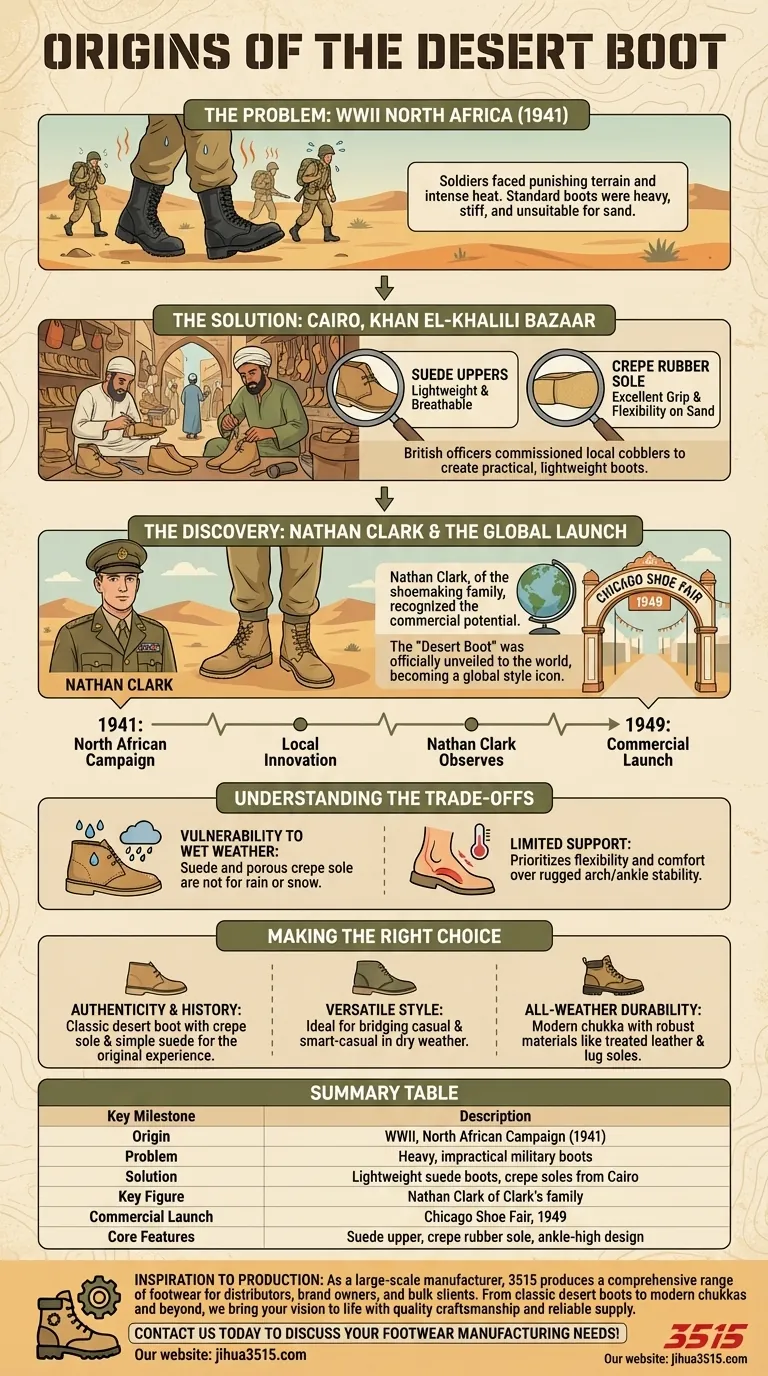The Desert Boot's origin lies not in a design studio, but in the battlefield. It was born out of necessity during World War II, when British Army officers stationed in North Africa sought a practical alternative to their heavy, impractical military-issue boots. The design was inspired by lightweight, sand-colored suede boots with crepe rubber soles they commissioned from local cobblers in Cairo's Khan el-Khalili bazaar.
The Desert Boot is a story of battlefield innovation, where a locally-crafted solution for desert warfare was observed, refined, and introduced to the world as a timeless piece of footwear.

The Problem: Unsuitable Boots for Desert Warfare
The genesis of the desert boot begins with a clear problem faced by soldiers in the North African Campaign of World War II.
The Demands of the Desert
The terrain was punishing, demanding footwear that was lightweight, breathable under the intense heat, and offered good traction on sand.
The Failure of Standard-Issue Boots
The standard military boots issued to soldiers were heavy, stiff, and poorly suited for the hot, dry conditions, leading to discomfort and reduced effectiveness.
A Solution from a Local Source
Frustrated officers of the British Eighth Army took matters into their own hands, finding a solution not from military suppliers, but from local artisans.
The Khan el-Khalili Bazaar
In Cairo's famous Khan el-Khalili bazaar, local cobblers were crafting simple, ankle-high boots that met the officers' needs perfectly.
The Key Materials: Suede and Crepe
These boots featured two crucial innovations: unlined suede uppers, which were lightweight and breathable, and a stitched-on crepe rubber sole, which provided excellent grip and flexibility on sand.
From the Battlefield to the Global Market
The genius of this local design was recognized by a soldier with a unique family background in shoemaking.
The Observation of Nathan Clark
Nathan Clark, a member of the Clark's shoemaking family serving with the British Army in 1941, noticed these superior boots worn by his fellow officers.
Commercializing the Design
Recognizing the commercial potential of this comfortable and practical design, he brought the idea back to his family's company.
The 1949 Chicago Shoe Fair
The C & J Clark company officially unveiled the "Desert Boot" at the Chicago Shoe Fair in 1949, where its simple silhouette and unique construction captured the attention of style editors, launching it to global popularity.
Understanding the Trade-offs of the Original Design
While the desert boot was a perfect solution for its intended environment, its core features come with inherent limitations.
Vulnerability to Wet Weather
The original combination of a suede upper and a porous crepe sole makes the boot highly susceptible to water. It is not a practical choice for rainy or snowy conditions.
Limited Arch and Ankle Support
The boot's design prioritizes flexibility and lightweight comfort over rugged support. Its unstructured nature offers minimal ankle stability or arch support compared to more robust boots.
Making the Right Choice for Your Needs
Understanding the desert boot's heritage helps you decide how it fits into your life.
- If your primary focus is authenticity and history: Seek out a classic desert boot made with a genuine crepe sole and a simple suede upper to experience the original design.
- If your primary focus is versatile, three-season style: The desert boot is an ideal choice for bridging casual and smart-casual attire in dry weather.
- If your primary focus is all-weather durability: Consider a modern "chukka" boot that shares the desert boot's silhouette but uses more robust materials like treated leather and a rubber lug sole.
Ultimately, the Desert Boot endures because its design was perfected by its purpose long before it ever became a style icon.
Summary Table:
| Key Milestone | Description |
|---|---|
| Origin | WWII, North African Campaign (1941) |
| Problem | Heavy, impractical military boots for desert warfare |
| Solution | Lightweight suede boots with crepe soles from Cairo's Khan el-Khalili bazaar |
| Key Figure | Nathan Clark of the Clark's shoemaking family |
| Commercial Launch | Chicago Shoe Fair, 1949 |
| Core Features | Suede upper, crepe rubber sole, ankle-high design |
Inspired by the timeless design of the desert boot?
As a large-scale manufacturer, 3515 produces a comprehensive range of footwear for distributors, brand owners, and bulk clients. Our production capabilities encompass all types of shoes and boots, from classic styles like the desert boot to modern chukkas and beyond. We can help you bring your vision to life with quality craftsmanship and reliable supply.
Contact us today to discuss your footwear manufacturing needs!
Visual Guide

Related Products
- Safety Footwear Wholesale Manufacturer for Custom OEM/ODM Production
- Wholesale Comfortable Business Casual Shoes Custom Manufacturing
- Wholesale Safety Footwear Manufacturer for Bulk & Custom OEM Orders
- Factory Direct Wholesale Rain Boots Durable Waterproof & Fully Customizable
- Premium Wholesale Wheat Nubuck Safety Boot with Rapid Lacing System
People Also Ask
- What do heavy duty boots do? Protect Your Feet in Demanding Work Environments
- What are OSHA approved shoes? Understanding the Correct Standards for Workplace Safety
- What are the differences between steel toe, composite toe, and alloy toe Wellington boots? Choose the Right Safety Toe for Your Job
- Is it normal to wear shoes in the house? A Guide to Hygiene, Comfort & Culture
- Do snake bite boots work? Your Ultimate Guide to Effective Snake Bite Protection



















